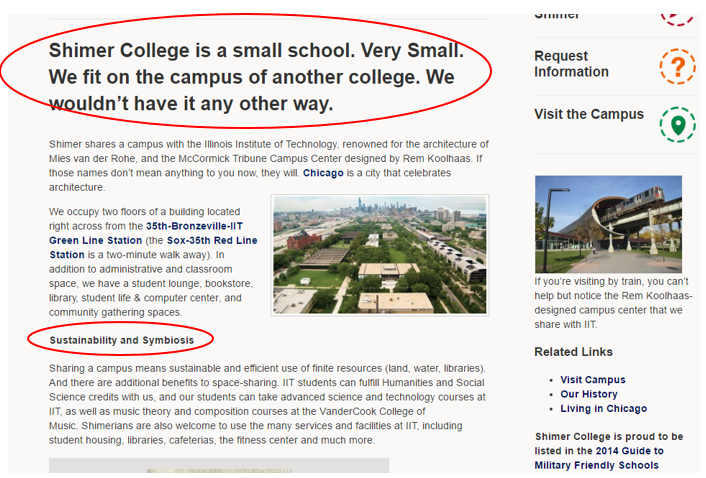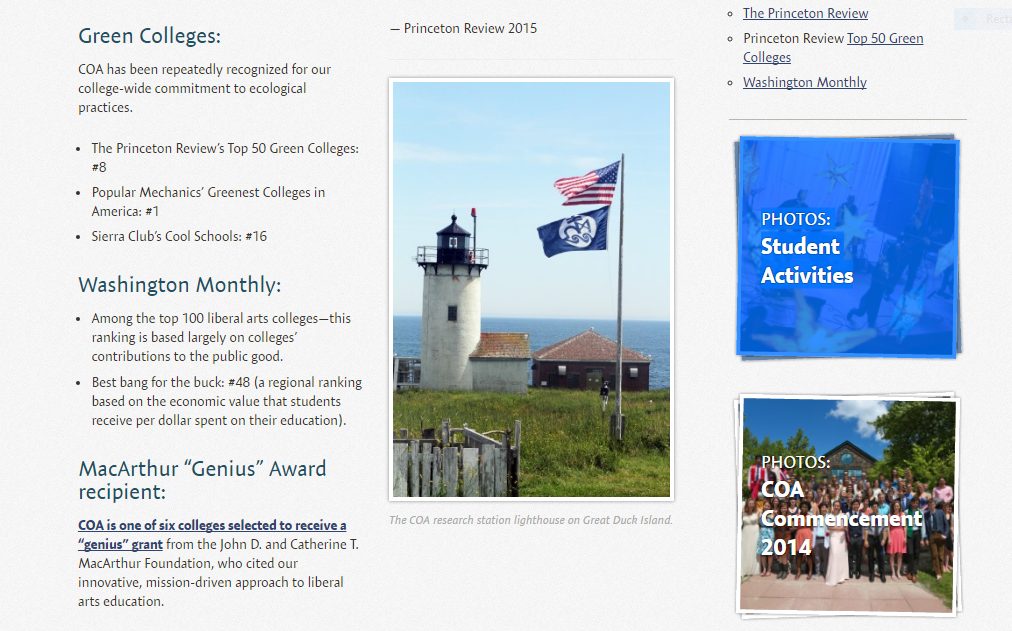A volatile economy, rising tuition costs, fear of student debt, and mounting uncertainty around the “worth” of a college education have made promoting small colleges and recruiting and retaining students extremely challenging over the last several years.
With their predominant reliance on tuition to cover operating costs, small institutions are particularly vulnerable to cash flow problems, high debt, and bankruptcy.
And if you’re a small liberal arts college, you’ll also have to contend with students’ growing preoccupation with educational “ROI,” which tends to steer them toward career-oriented programs that track directly to “in-demand” jobs right after graduation.
Many small colleges respond by trying to compete with larger institutions, copying their marketing tactics, and skimming over the size issue altogether – instead of leveraging it to their full advantage.
In this post, we’ll look at small (mostly liberal arts) college visibility strategies. These colleges effectively set themselves apart as uniquely desirable because of their small size (rather than despite it).
Focussing predominantly on website content (your most valuable channel for student recruitment), we’ll highlight six key angles small colleges can use to play to their strengths, stand out from competitors, and attract today’s value-conscious students.
1. Declare Your “Small Size Advantage” Up Front on Your Homepage
Even if visitors don’t land directly on your homepage, they’ll quickly end up there during their exploratory, information-gathering process. Prospective students and parents will use your homepage not just to orient themselves and survey their navigational options but also to catch a glimpse of your character as a college—the values and attributes that best represent your mission as a place of learning.
For smaller colleges, this means tackling the issue of size head-on. Use this introductory space to deliver a unique “small size advantage” proposition that will resonate with the specific audiences you’re hoping to attract.
Here’s a great example from College of the Atlantic. Every element of this homepage collaborates to articulate a clear brand identity and emphasize the advantages of keeping things small. “Welcoming,” “personalized,” “forward-thinking,” “selective,” “intriguing,” “intelligent,” “collaborative,” “specialized,” and “inspiring” … are just a few of the key terms that come to mind when I see this homepage:
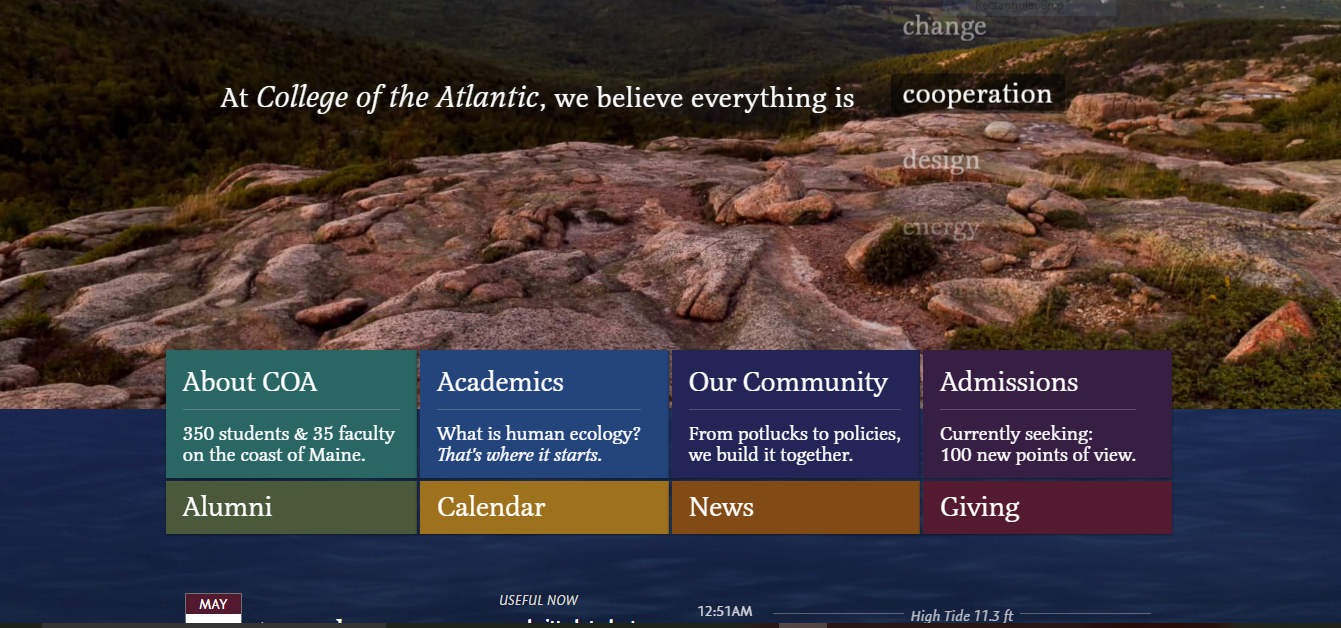
College of the Atlantic has successfully deployed many of the content tactics outlined in this post, so we’ll return to them again for examples and best practices. But in the meantime, let’s look at how Shimer College (a school with under 200 students) nails this next pillar of small-school promotion.
2. Showcase Students’ Political Clout at Your College
Big universities run like large corporations, with a top-down decision-making process rarely relying on direct student input. Small colleges, on the other hand, are uniquely equipped to flip that paradigm by making students an integral part of governance.
Shimer College takes this notion to the next level by centralizing student political involvement in its promotional messaging, brand identity, and educational approach. Here’s a look at the college’s “How it Works” section, where this democratic philosophy is outlined:

Not every small college must include students in administration, marketing, and policy-making – but it is wise to highlight how choosing to remain small opens many doors for students to assert themselves, be seen and heard, and affect meaningful change.
Reassuring prospects that they will never be anonymous or get lost in the shuffle should be a key theme of your content strategy for student recruitment. As should significant benefits of student-college collaboration, such as:
- Hands-on experience learning how to run an institution
- Discovering what it takes to negotiate and lead
- Learning how to build and maintain productive working relationships
- Understanding how to affect real change within an institutional context
3. Angle Small College Marking Towards Resolving Doubts About Availability of Campus Resources
We’ll stay with Shimer College to illustrate how small colleges can reassure prospective students that while the campus may be small, they will still have access to the latest technology and research facilities.
Small institutions typically forge partnerships with other colleges or community organizations to ensure students have the wide range of resources they need to conduct research and grow as learners.
For Shimer, this means highlighting that their campus is situated on the grounds of a larger institution – the Illinois Institute of Technology. Shimer does a good job of reinforcing the advantages of this arrangement, such as the sustainable sharing of facilities and students’ freedom to take classes from both institutions.
The college addresses this issue up front on its website (there’s a link on its main navigation about the campus-sharing arrangement), ensuring prospects that “small” doesn’t mean limited:
Pomona University in California takes a similar approach, highlighting its inter-collegiate agreement and campus-sharing with four other colleges (a collective known as the Claremont Colleges). Their website is careful to explain precisely how students at Pomona benefit from this arrangement with access to courses at each partner school, as well as libraries and other campus resources.
To reassure parents and students, your content strategy for colleges must highlight access to resources and facilities on their websites—their most important and persuasive tool for student recruitment. With larger institutions constantly luring applicants with shiny new facilities (dorms, sports complexes, performing arts centers, science research centers, etc.), smaller colleges must ensure their students won’t be left wanting learning resources.
4. Illustrate the Depth of Student-centered, Personalized Learning
Regardless of size, almost every university and college makes claims around student-centered, personalized learning. The difference between big and small colleges is that small colleges can substantiate those claims deeply and meaningfully.
Highlighting comparatively tiny class sizes and student-to-teacher ratios is a great start, but so is showcasing opportunities students have to forge supportive relationships with instructors and administration. And the chances they’ll have to participate in class discussions, genuinely connect with their peers, and feel invested in their college community.
These are considerable advantages for smaller colleges, particularly as customization and personalized attention grow increasingly important to prospective students. Intuitively, vibrant, thoughtful illustrations of your student-centered culture should be at the core of your content strategy and development.
Here’s a nice example from the Art Academy of Cincinnati, one of the smallest four-year art colleges in the United States. This is a shot from their Instagram account, showing a tiny class of students on an “urban field trip” with their professor. Authentic, intimate, distinctly un-institutional – and not something a giant undergraduate class of 100 would get to do:
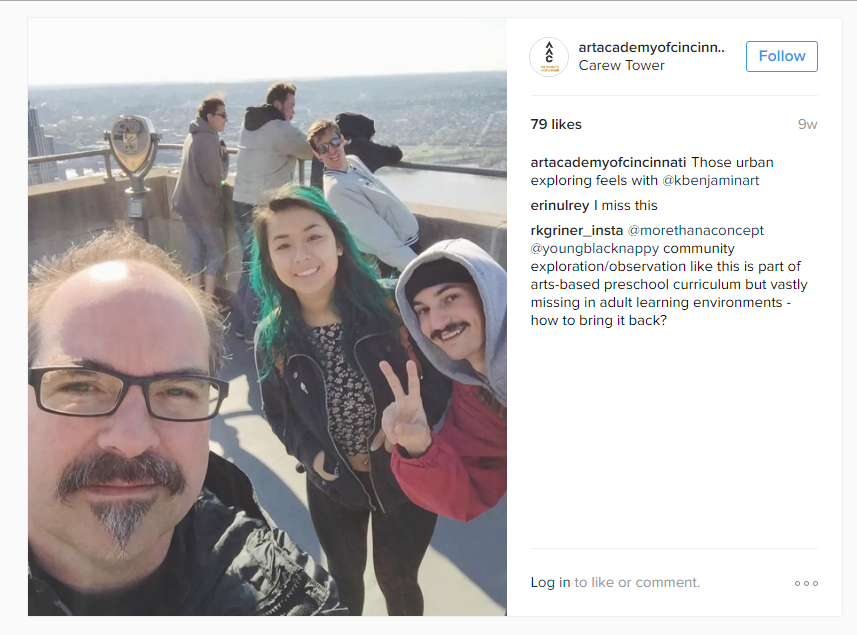
Now, we return to Shimer again to appreciate the sharp contrast they draw between their highly personalized admissions process and the more generic methods some bigger schools use to sift through applicants. Like Sterling, they’re happy to let students speak for the college, and the result is both entertaining and effective. Two undergrads host this video on Facebook, poking fun at mainstream application essay topics – like this random “take a risk” prompt from Notre Dame.

Why have I mentioned Shimer so often in this post? In many ways, it exemplifies the fiercely proud and defiant small school identity that has helped many non-traditional colleges overcome tough times. Don’t forget, this is the college that once ranked the number one worst school in America. And who came out to speak in Shimer’s defense? Its students and alumni. Many of them.
They spoke of Shimer’s distinctly student-centered culture, the rich knowledge and character-building experiences they gained in those tiny classes, and how they felt truly understood and welcomed within its close-knit scholarly community.
Shimer’s student testimonials were so heartfelt, they attracted the attention of The Guardian whose subsequent investigation helped reveal just how progressive and beloved this school really is (and largely misunderstood by critics).
Since then, Shimer has focused on enhancing its web presence and has managed to stem the fallout from the disastrous ranking results. Most recently, North Central College (also in Illinois) announced plans to merge with Shimer, effectively “acquiring” the school while preserving its distinct Shimerian brand. Shimer president Dr. Susan E. Henking says, “Shimer is thrilled to have this opportunity to sustain our mission in a new context…”
This is to say that small colleges can excel at cultivating and widely promoting a deep sense of community, belonging, and personalized support and leverage this to sustain their well-being and attract a new generation of students.
5. Articulate Key Messages that Play to Your Small College’s Advantage
Because small colleges often target highly niche audiences, they must clarify a mission and values that will resonate with that audience and motivate enrollment. These key messages should be persuasively packaged, presented on the college website, and echoed consistently across all other recruitment channels. These sentiments will distill your uniquely attractive small college identity while clarifying how your target audience will benefit from joining your community.
We’ll revisit the College of the Atlantic to view a well-executed articulation of critical messages on their About Us page. Here you have, all in one place, a clear representation of the COA identity and the top reasons to select this unique college (which, by the way, offers only one major: a Bachelor of Arts in Human Ecology):

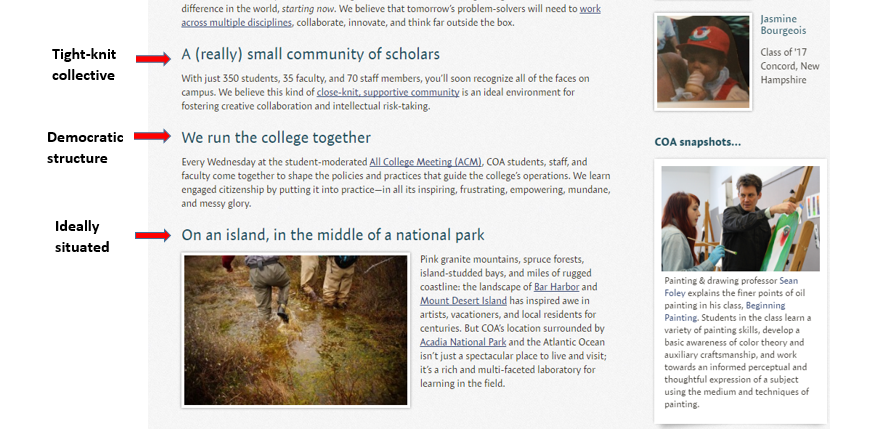
College of the Atlantic’s promotional strategy and innovative educational approach has undoubtedly served it well. It ranks among the top 100 liberal arts colleges in the US and holds the #11 spot for “best value.”
COA has also snagged top honors in categories such as “most beautiful campus,” “beloved by students,” “best quality of life,” and “greenest college in America.” It has built a widely recognized, credible, attractive brand that can rival a “big” school any day of the week.
6. Reserve a Special Website Section for Accolades & Success Stories
Speaking of top honors and positive ranking results – it’s vital to showcase these prominently on your website, in a dedicated section that prospective students can browse through while researching your institution and programs.
This is best practice for any educational institution or program, but truly crucial for a smaller college with less “brand prestige” than a big ticket school.
Smaller college’s may have to work a little harder to prove their legitimacy and “ROI” to prospective students, who want to ensure the institution they select can successfully prepare them for graduate school and a competitive job market.
Here’s another strong example from the College of the Atlantic, which makes its Rankings & Accolades section impossible to miss by linking to it from the homepage:

And here’s the page itself, which includes testimonials from students, high praise from prestigious reviewers, and a long list of top rankings:

And if your small school hasn’t yet collected top reviews or star rankings? Use this section to present the success stories of your graduates, the number of students who gain admission into top graduate programs, and stories of how your unique educational environment helps current students grow and thrive.
Above all, this section should reassure visitors of your legitimacy and inspire them to take the following steps toward enrollment (so don’t forget to include a Request Info form to prompt inquiries while the iron’s hot!)
In a nutshell, these are the six key angles for your content strategy:
Declare Your “Small Size Advantage” Up Front on Your Homepage, Showcase Students’ Political Clout at Your College, Angle Small College Marking Towards Resolving Doubts About Availability of Campus Resources, Illustrate the Depth of Student-centered, Personalized Learning, Articulate Key Messages that Play to Your Small College’s Advantage and Reserve a Special Website Section for Accolades & Success Stories.
What steps has your small college taken to assert a unique brand identity that resonates with prospective students? What do you think is most important to remember when promoting a small school? We welcome your questions and insights in the section below.
FAQs To Consider:
How do I attract college students to my business?
Say that small colleges can excel at cultivating and widely promoting a deep sense of community, belonging, and personalized support and leverage this to sustain their well-being and attract a new generation of students.
What is the education content strategy?
Declare Your “Small Size Advantage” Up Front on Your Homepage, Showcase Students’ Political Clout at Your College, Angle Small College Marking Towards Resolving Doubts About Availability of Campus Resources, Illustrate the Depth of Student-centered, Personalized Learning, Articulate Key Messages that Play to Your Small College’s Advantage and Reserve a Special Website Section for Accolades & Success Stories.



